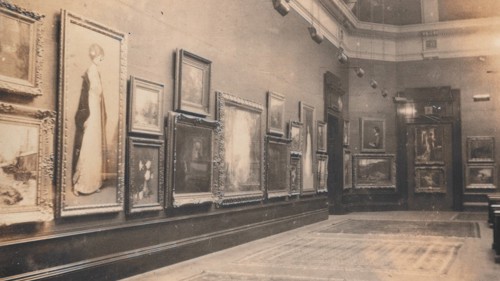Royal Glasgow Institute of Fine Arts - Times Past

The Royal Glasgow Institute of The Fine Arts (RGI) has played a vital part in the city’s arts development and promotion since its establishment on 29th May 1861. It was founded by a group of artists and businessmen in Glasgow, with a view to holding regular exhibitions of living painters and sculptors from the Glasgow and West of Scotland area.
By the 1860’s Glasgow was a major industrial and trade centre, and so unsurprisingly was growing as a cultural hub. The city was full of theatres, concert halls and libraries, so the additional of an annual art show for living artists had been discussed for some time by various groups eventually leading to the creation of the Glasgow Institute of Fine Arts.
Its annual exhibitions were an immediate critical success (with moderate financial profits too) as recorded in its minute and sales books, now in the care of the City Archives. The first exhibition was held at the Corporation Galleries (now McLellan Galleries) on Sauchiehall Street hired from the Glasgow Corporation, and it proved extremely popular, attracting 39,099 visitors. With the majority of tickets sold being ‘Working Man Tickets’, the first exhibition demonstrated that there was an enthusiasm for new art amongst the general public in Glasgow, not just within art dealing circles.
In 1879 a new purpose-built gallery was built on Sauchiehall Street, as the number of works shown increased and due to the large attendance figures for the annual shows. Over the years the institute’s exhibitions displayed works not just by local artists, but international works too. Artists such as Turner, Constable, Poynter, Burne Jones, Whistler, Renoir, Hornel, Gauld, Lavery and Guthrie were all included in exhibitions as well as later key 20th Century artists such as Peploe, Leslie Hunter and Cadell. The decision to host works that highlighted new developments in art have inspired local artists, for example the internationally renowned group the ‘Glasgow Boys’ who were hugely influenced by the then modern works of French painters exhibited by the institute.
In 1896 the institute received its Royal Charter in recognition of its achievements, and by this time the annual exhibitions were as much of a fixture in the British art scene’s calendar as those of London’s Royal Academy and Edinburgh’s Scottish Royal Academy. However, in 1902, high running costs meant the institute sold its gallery building (to department store Pettigrew & Stephens) and returned to hiring the McLellan Galleries.
From the start the institute promoted new and contemporary art. Despite leaning to more conservative art in the 1920’s and 1930’s, the institute nowadays is back to its original aims, including more experimental and modern works. For many years its annual art show was Scotland’s largest, and it continues to encourage new and forward-thinking artists in its exhibitions today.
